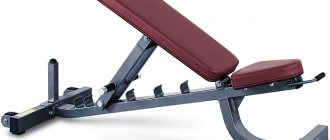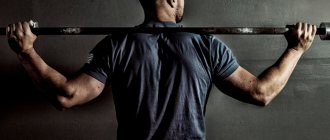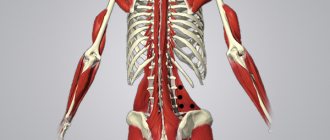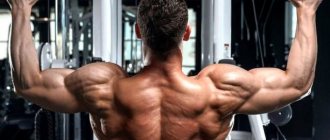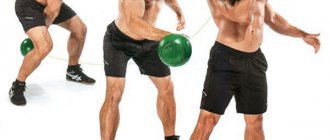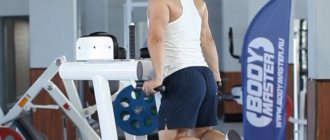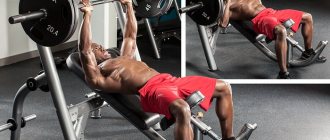Powerful chest plates are the calling card of any serious bodybuilder. And we can endlessly talk about the importance of pumping up the whole body - most beginners focus primarily on the core. The exercises for the pectoral muscles in the gym given in the article will help you build large and beautiful muscles. The movements and complexes are designed for men, but girls are also recommended to use the “classics” - in return they will get an excellent figure.
Male breast anatomy
The pectoral muscles cover a third of the body in front and consist of the following subgroups:
- Large muscle - occupies the main part of the chest and lends itself well to pumping. Controls lifting, turning and bringing the arms to the body.
- Minor muscle - located under the main muscle and does the job of raising the ribs and pulling the shoulder blades forward.
- Serratus anterior – located on the sides from the ribs to the shoulder blades. Pulls the scapula forward and also rotates it when raising the arms.
- Subclavian - located next to the collarbone above the upper rib. Moves the collarbone inward and downward.
- Intercostal muscles - located between the ribs and are involved in the breathing process.
The best chest exercises in the gym
The basic exercise for the pectoral muscles is the bench press. We recommend this exercise to beginner athletes.
The advantage of the exercise is the ability to change the angles of the bench, thereby you can pump the lower and upper parts of the pecs, which is important in training.
When you lie on a bench with your head down, the lower part of your chest is pumped, and with a positive tilt, the upper zone of the pectoral muscles begins to work.
Pump up your pectoral muscles on the Hummer machine
The auxiliary equipment, due to the conditioned trajectory of movement of the levers of the block-loading simulator, pumps up the pectoral muscles to the maximum and, in addition, the triceps and anterior deltoids. Perform it after a basic set of exercises for the pectoral muscles in the gym. The machine is great for progressive fractional sets.
- Sit in a chair, adjust the height of the seat to suit your height and press against the back.
- Bring your shoulder blades together and push the levers forward without fully straightening your elbows.
- Try to always keep them unfolded.
- Pause for a moment and return to the start.
Hammer press
You already know all the types of bench presses in a horizontal position, now let's look at chest exercises on machines. We'll start with the Hummer press, which, in addition to the pectoral muscles, indirectly loads the triceps and anterior deltoids.
Technique:
- Set the working weight and select the desired seat angle. In the starting position, your hands should be at the lower part of the sternum. Sit in the simulator, bring your shoulder blades together. The head and chest should be directed forward. This is your starting position.
- As you exhale, press the weight forward, straightening your arms.
- Take a short pause, then, while inhaling, return to the original position. To keep your chest muscles engaged at all times, do not lower the weight completely.
- Do the required number of repetitions.
Push-ups with wide hands on the pectoral muscles for men
One of the simplest, but at the same time, the best exercises for working the pectoral muscles. It does not require additional equipment and exercise equipment; it can be performed in any convenient place. Work 3 sets of 8-12 times.
Note that:
- Using arm rests allows you to go lower and therefore better stretch your pecs.
- If a man thinks that classic push-ups are not enough, then you can add pancakes to your back.
Features of proper pumping of the pectoral muscles
Working the pectoral muscles when performing dumbbell flyes in a lying position
Do you want to know how to pump up your chest? Experts identify three main reasons why the majority of training people cannot boast of impressive pectoral muscles:
- Incorrect emphasis on the load when only some areas of the pectoral muscles are trained.
- The trainee is not able to correctly feel the work of muscle fibers during exercises. This in turn can lead to microtrauma of muscle fibers.
- The main reason for the growth of muscle fibers is the stress that the muscles experience during exercise. If there is no increase in training weights for a long time, this provokes stagnation in muscle development.
In addition to the factors described above, the correct technique is also necessary, thanks to which the brain can select the optimal range of movements, achieving a high-quality contraction of the trained muscle. Thus, if you use the correct muscle pumping technique, you will very soon notice the results of your efforts.
We also recommend studying this topic:
How to pump up your chest with a barbell: a set of exercises for quick results
15073 0 0
Readers found these materials useful:
- Push-ups for the upper and lower pectoral muscles
- How to pump up your chest with a barbell: a set of exercises for quick results
Reduction of arms in a crossover on the pectoral muscles for men
We set the warm-up weight (no weight for women and 5–10 kg for men):
- We take hold of the pre-installed handles. Palms face forward.
- With slightly bent arms, we bring the arms together at the level of the stomach. In this position, we turn our elbows up. This will be the starting position.
- Throughout the entire exercise, the elbows look up.
- Look straight ahead. It is best to perform mixing in front of a mirror - you will clearly see all your mistakes and correct them in time.
https://youtu.be/FCv2ezfcn5g
Warm up - 10-15 times, then hang the working weight and do 10-12 repetitions in 3-4 approaches. The lower you bring your arms, the more the lower chest will be loaded.
Chest muscle training[edit | edit code]
In bodybuilding, there are two main ways to develop chest muscles:
- using special means and training methods designed to increase chest volume;
- performing exercises to increase chest muscles, as well as working on their shape and relief.
To enlarge the chest muscles, the result is a combination of weight training exercises that stimulate breathing and exercises that increase the volume of the chest. The greatest effect can be achieved at a young age (14-20 years), when the athlete’s cartilage tissue is still plastic and easily stretchable.
Experienced bodybuilders use a program for this that combines squats with a barbell on their shoulders with a pullover—carrying a weight behind the head and back with slightly bent arms. The last exercise is performed in a lying position on a horizontal bench.
These exercises are usually combined into a super series and performed 3 times a week. First, squats with a sufficiently large weight, ensuring maximally activated breathing by the end of the exercise. Before the pullover, a minimal break for rest is possible, but more often it is not taken at all. The second exercise is performed with light weight, since its main task is to work on increasing the volume of the chest.
Beginning athletes should not do more than 2 such super series in training (each exercise is performed 25 times). The rest between them should be 3-4 minutes.
Experienced athletes usually do 3, and masters - 4-5 such super series. The time for their implementation is selected individually: some do super series at the beginning of the workout, others at the very end.
The most experienced bodybuilders, pursuing the same goals, use another program:
- bench press (2 x 12);
- Bent-over barbell rows to the chest (2 x 12);
- overhead press (2 x 10);
- curling arms with a barbell or dumbbells (2 x 10).
After these exercises, perform 4 super series, consisting of squats and pullovers (squats 15 times, pullovers 20 times). After the 1st set of squats, the weight of the barbell should be increased by 5-10%. Each subsequent pullover is performed with some weight.
This program should be performed no more than 3 times a week (for 2-4 months).
For beginner athletes, there is a chest development program without weights. It includes the following types of exercises:
- parallel bars push-ups (10 times in 4 approaches);
- deep squats on toes in a position where hands are on the belt (10-15 times in 4 approaches);
- chest exercises performed between squat sets. Stretch your arms forward so that your palms rest on some horizontal surface. The legs are straight, the back is slightly arched at the lower back. It is better to perform 4 series of 10 repetitions;
- pull-ups on the bar (4 series of 8-10 repetitions);
- squats on one leg, performed between approaches to the bar (4 series of 10 times for each leg).
There is another popular program option for developing chest muscles. It includes the following sequence of exercises:
- squats (15-18 times with enough weight to warm up);
- pullover (12-15 times with light weights);
- squats (10-12 times with increasing weights);
- lying dumbbell flyes (12-15 times with light weights);
- squats (8-10 times with increasing weight);
- pullover (12-15 times with light weights);
- squats (5-6 times with increasing weight);
- raising dumbbells to the sides (10-12 times with increasing weight);
- squats (3-4 times with almost maximum weight);
- pullover (10-12 times with increasing weights).
There are many programs to increase the volume of the chest muscles. Maybe someone will like the following set of exercises.
- Dumbbell bench press on an incline bench (4-5 sets of 6-12 reps). It should be noted that the dumbbell pullover is very popular among athletes. It is performed in the same way as a pullover with a barbell. To maximize the effect of stretching the pectoral muscles, it is performed while lying across a bench.
- Bench press (4-5 sets of 6-12 reps). This exercise is basic for the chest muscles and has variations: bench press on an inclined bench (with an inclination angle of 30-40°). This exercise is very effective for developing the upper pectoral muscles. Most often it is performed with a medium (slightly wider than shoulder width) or wide grip. At the same time, the triceps and the front part of the deltoid muscles also work, the load on which increases with increasing angle of the bench. Absolutely precise adherence to the technique of performing this exercise allows you to maximally load mainly the pectoral muscles. You can use a slightly wider than average grip, which will allow you to work mainly the middle part of the chest muscles. An even wider grip allows the outer parts of the pectoral muscles to work. With the correct technique for performing this exercise, your elbows should be spread to the sides. If the elbows are moved closer to the body, this increases the load on the triceps;
- The close-grip bench press is usually performed to train the inner part of the pectoral muscles, although a fairly large load is also placed on the triceps;
- Reverse bench press. To perform this exercise, it is best to use a special simulator, the angle of inclination of the back of the bench is 15-20°. In this case, most of the load falls on the lower part of the pectoral muscles.
- Dumbbell flyes lying on an incline bench (3-4 sets of 10-12 repetitions). The exercise is one of the most popular for working the chest muscles. They perform it at a slow pace, without making the task easier for themselves due to the force of inertia. The elbows should be slightly bent, especially in the extreme extension position.
- Reduction of arms on blocks (3-4 sets of 10-15 repetitions). This exercise is used to work the lower part of the pectoral muscles. It also needs to be performed with your elbows slightly bent to avoid injuries to the elbow joints.
- Dips (3-4 sets of 10-15 reps). An excellent exercise for working the outer part of the pectoral muscles. When performing this exercise, your elbows should be spread to the sides. If you place them closer to the body, the main load will fall on the triceps.
Barbell chest press for men
Suitable for beginners. This is the basis and in its principle the exercise is one of the variants of push-ups from the floor. When the incline of the bench changes, the impact zones shift and this is one of the main advantages of the bench press. In a positive tilt the upper chest works, in a head down position the lower chest works. For the pectoral muscles, this is an ideal training for strengthening and building mass. The number of approaches depends on the training program, but usually there are 3-4 with repetitions 6-12 times.
Starting position:
On the bench, take a lying position, with your buttocks, shoulders and head pressed against its surface. The back is slightly arched in the lower back, the legs are shoulder-width apart with the feet resting on the surface of the floor.
The barbell is taken with a wide grip and removed from the thrust mechanisms, then raised parallel to the middle of the chest to the peak level. If necessary, you can resort to the help of a partner.
Technique:
On a deep breath, the projectile drops to the lower limit (it should lightly touch the body). Breathing is fixed.
The bar is pressed up to the starting position with a powerful exhalation towards the end. At the peak there is a short pause, the pectoral muscles tense to the limit.
You need to lower the barbell without jerking, the movement should be smooth and unhurried. But it should be lifted with a moderately quick movement, while it is important not to allow the back to bend, and the projectile should not be springy from the body.
Do you want to lose weight? Then these articles are for you
At what heart rate does fat burn?
Lost weight Anna Mikhalkova: photo, technique
Training program for weight loss in the gym for girls
Bench press at an angle
This chest exercise in the gym is used to work the upper bundle of the pectoral muscles. As a rule, it is he who “lags behind” for many athletes. In addition to the chest, this movement indirectly targets the anterior deltoids and triceps brachii.
Technique:
- Sit on a bench with an angle of 30-45 degrees. Grasp the barbell with a grip similar to a classic bench press. Remove the projectile from the stand, then lift it above you. This is your starting position.
- As you inhale, lower the barbell slowly and under control until it touches your chest. At the lowest point, pause for a second, feeling the work of the pectoral muscles as much as possible.
- As you exhale, return the bar to its original position.
- Fix your arms, maintaining tension in the chest muscles, and then slowly lower the projectile down. During execution, it must move strictly along a vertical trajectory.
- Repeat the movement as many times as necessary.
Dumbbell chest press for men
The exercise is done lying on a horizontal bench or at an incline; in this case, dumbbells are used instead of a barbell.
This modification develops the chest muscles more symmetrically and requires balance. Hold the dumbbells with your thumbs facing each other.
The initial position of the arms is that the elbows form a right angle to the body, the dumbbells are raised in the hands. As you inhale, lift the dumbbells above your body, and as you exhale, lower them.
In the top position, tighten your arm muscles to increase the load on your inner chest. It is permissible to turn your palms upward towards each other - this will load the middle part of the chest.
Reduction of arms in the butterfly simulator
Another chest exercise in the gym, aimed at isolated chest work.
It is performed as follows:
- Adjust the machine so that your shoulders are parallel to the floor during the working set. Select the required working weight. Sit on the machine with your elbows on its flat back. This is your starting position.
- As you exhale, slowly bring the handles of the exercise machine towards each other, feeling the tension in your chest as much as possible. Stop for a second.
- As you inhale, return to the starting position, fully stretching your pectoral muscles.
- Repeat the movement as many times as necessary.
Chest push-ups with wide arms
The bars should be comfortable to use, not too wide or narrow, ideally slightly wider than shoulder width.
Bars are a universal sports equipment that can develop the body comprehensively. Chest, triceps, trapezius, forearms, shoulders, and also strengthen ligaments and tendons.
Do you want to lose weight? Then these articles are for you
Stevia: benefits and harms, reviews
Water aerobics for weight loss: exercises in the pool
How many calories are in a fresh tomato?
Push-ups on parallel bars are practiced in all educational or sports institutions, because the movement is as simple and natural as possible, and it also helps to lay the foundation for further sports.
Starting position
Climb onto the bars, arms straight, look ahead, body straight.
Execution technique and recommendations
- We lower ourselves slowly, listen to our body, feel the tension - and as we exhale we rise sharply.
- The arms are straightened completely, the body should become one straight line, we do not go too low in order to protect the elbow joints and brachioradial ligaments from excessive stress.
- If, when pumping the triceps, the elbows slide along the body, then in the case of the chest they need to be moved apart, thereby opening the muscle fibers and forcing them to take the entire load on themselves.
- Each approach is performed to failure; choose the number of sets yourself, based on the preparedness of your body.
Useful tips
When performing strength exercises, remember the following recommendations:
- Mandatory warm-up . The initial stage of training should be working out the muscle group of the shoulder girdle. This will prepare the ligaments and muscles and avoid injury. Warm-up rules: it should be aimed at warming up and stretching the target muscles. Instructors recommend focusing on developing the shoulder joint.
- Alternating tension and relaxation . Muscle tension as you exhale, relaxation as you inhale. This rule should be executed automatically.
- Using weight . When selecting weight, consider your level of physical fitness. It's better to start with minimal load.
- Increase the number of repetitions gradually . As the muscles are worked and strengthened, you can perform twelve exercises with three repetitions.
- Training mode . Don't train every day - your muscles need to rest and recover. Training every other day is the best option.
- Carefully! If pain occurs in the shoulder joint, you should stop exercising and postpone the workout to the next day. If the pain does not go away, consult a doctor to rule out the possibility of injury. Shoulder injuries are dangerous and take quite a long time to heal.
- Balanced diet . It is important that you have enough energy for strength training. This requires a complete intake of proteins, minerals, and vitamins into the body.
- Drinking regime . Don’t forget to drink, keep a bottle of water handy, as the body loses quite a lot of fluid through sweat.
Strength training helps strengthen muscles, shape the relief and help increase their volume. Regular exercise gives excellent results and helps you gain a slim and courageous figure.
Improve the shape of your breasts from the bottom bun to the top!
If you're serious about improving your upper torso, give this workout a try. You'll be lifting enormous weights, challenging every muscle fiber, aiming for high training volume, and leaving the gym completely exhausted!
Athlete and elite bodybuilding coach Dylan Thomas doesn't always train pecs on Mondays and shares his secrets on how to pump up pectoral muscles in the gym for every man. He uses a set of exercises that maximally stimulates all processes associated with muscle growth and loads every muscle fiber from the bottom to the top of the chest.
He shares: “When working the chest, I like to work from the top to the bottom. This means I start on an incline with my head up, then move to a flat surface, and then I do incline exercises with my head down, or dips.”
His one-hour chest workout program includes other exercises as well. Pre-fatigue? Eat. Heavy weights for mechanical stress? Eat. Supersets and sets to failure for maximum muscle destruction? There is another way.
Don’t let the same type of exercises and repetition schemes fool you. This is advanced bodybuilding of the highest standard, and it is perfect for everyone who wants to reach heights.
Thomas says, “I like to do this routine to sharpen my contours before a photo shoot or competition.”
Do you want to lose weight? Then these articles are for you
Oatmeal pancakes - recipes for every taste!
How many calories are burned when cycling?
Motivation for losing weight before and after photos
Negative Incline Bench Press
As a rule, this movement is used by athletes whose lower bundle of pectoral muscles lags behind. We would like to say right away that during this exercise your blood pressure can rise significantly, so if you have certain problems with this, we strongly recommend that you do not add it to your training program.
This chest exercise is performed in the gym as follows:
- Lie on a negative incline bench with your feet under the bolsters. Take the projectile with a straight, wide grip and remove it from the rack. This is your starting position.
- While inhaling, slowly lower the barbell to your lower sternum. While in this position, hold for no more than a second.
- As you exhale, return the projectile to the starting position. At the top point, contract your chest muscles, and then slowly begin to lower it again.
- Do as many repetitions as you need.
Recommendations for implementation:
- Be sure to use the help of an insurer, especially if you are new. If there is no one in the gym, choose a light working weight.
- Don't throw the projectile too far forward.
- Don't swing the barbell and do all repetitions under control.
Common mistakes in training the pectoral muscles
When pressing, the barbell should not bounce off the chest. Also, you should not jerk the barbell, because when the load moves by inertia, your muscles are not loaded.
When pressing dumbbells at the end of the approach, you should not throw the equipment on the floor. This damages the rotator cuff. You need to place dumbbells on your hips and at the same time raise your torso. Then just lower the dumbbells to the floor.
Movements during training should be smooth and with maximum amplitude. When doing this, always keep your elbows slightly bent to prevent wear and tear on the elbow joint.
2-3 days before chest training, do not pump up your deltoids and triceps, otherwise the effectiveness of the workout will sharply decrease.
COMPLEX[edit | edit code]
Equipment list
: a pair of collapsible dumbbells + a large inflatable ball. Just!
- 5 minutes of light cardio (jumping rope or running in place)
- Circular movements with straight arms 10 repetitions (each arm)
- Elbow circles 10 reps (each arm)
- Oblique flyes on the ball 2-3 x 20
- in a superset -
- Incline press on the ball 2-3 x 20
- Flyes on the ball 2-3 x 20
- in a superset -
- Horizontal press on the ball 2-3 x 20
- Push-ups on the ball (feet on the ball) 2-3 x 20
- in a superset -
- Push-ups on the ball (hands on the ball)
Notes:
When performing a superset, do not pause between exercises. Rest 60 seconds between supersets of two exercises. Between different supersets - 2 minutes.
Oblique breeding[edit | edit code]
Start:
Take an inclined position on the ball. Bend your knees. Place your feet firmly on the floor with their entire surface. Hold dumbbells above your chest with straight arms.
Performance:
Fill your chest with a deep breath and hold your breath. Extend the dumbbells exactly to the sides along the correct arc trajectories. At the bottom point, take a short break and repeat the movement in reverse order. Exhale.
Note:
Static tension in the buttocks helps maintain balance.
Super tip:
Over time, place your feet narrower to increase the instability of your body position and, thereby, complicate the exercise.
Incline dumbbell ball press[edit | edit code]
Start:
Take an inclined position on the ball. Bend your knees. Place your feet firmly on the floor with their entire surface. Hold dumbbells in bent arms above your shoulders.
Performance:
Fill your chest with a deep breath and hold your breath. Powerfully press the dumbbells upward onto straight arms. At the top point, pause briefly and return the dumbbells to the starting position. Exhale.
Note:
Push the dumbbells as high as possible. To do this, at the end point of the press, push your shoulders up.
Super tip:
When you have mastered the exercise well, perform the press with one arm alternately.
Flyes on the ball[edit | edit code]
Flyes on the ball
Start:
Take a horizontal position on the ball. Bend your knees. Place your feet firmly on the floor with their entire surface. Hold dumbbells in straight arms above your chest.
Performance:
Fill your chest with a deep breath and hold your breath. Extend the dumbbells exactly to the sides along the correct arc trajectories. At the bottom point, take a short break and repeat the movement in reverse order. Exhale.
Note:
Push the dumbbells as high as possible. To do this, at the end point of the press, push your shoulders up.
Super tip:
Over time, place your feet narrower to increase the instability of your body position and, thereby, complicate the exercise.
Dumbbell bench press on a ball[edit | edit code]
Start:
Take a horizontal position on the ball. Bend your knees. Place your feet firmly on the floor with their entire surface. Hold dumbbells in bent arms above your shoulders.
Performance:
Fill your chest with a deep breath and hold your breath. Powerfully press the dumbbells upward onto straight arms. At the top point, pause briefly and return the dumbbells to the starting position. Exhale.
Note:
Push the dumbbells as high as possible. To do this, at the end point of the press, push your shoulders up.
Super tip:
When you have mastered the exercise well, perform the press with one arm alternately.
Push-ups on the ball (foot rest)[edit | edit code]
Push-ups on the ball (foot support)
Start:
Take a position with your arms straight on the floor. Place your feet on the ball. Statically tighten your abs, keeping your body straight.
Performance:
Fill your chest with a deep breath and hold your breath. Bend your elbows and lower yourself toward the floor. After a short pause, push yourself powerfully into straight arms. Exhale.
Note:
Push up explosively. From set to set, change the width of your arms.
Super tip:
When you have mastered the exercise well, place your feet on the ball, pressing them together.
Push-ups on the ball (hand rest)[edit | edit code]
Start:
Take a position with your arms straight on the ball. Spread your feet and rest your toes on the floor. Statically tighten your abs, keeping your body straight.
Performance:
Fill your chest with a deep breath and hold your breath. Bend your elbows and lower yourself onto the ball until your chest touches it. After a short pause, push yourself powerfully into straight arms. Exhale.
Note:
Push up explosively. Do not press your elbows to your body. This will transfer the load to the triceps, taking it away from the pectoral muscles.
Super tip:
When you have mastered the exercise well, place your feet on the floor, pressing them tightly together.
